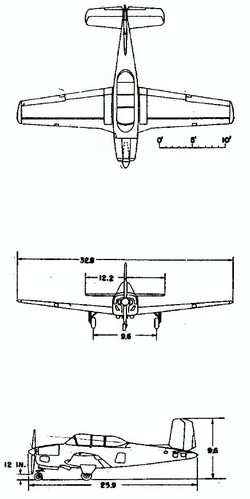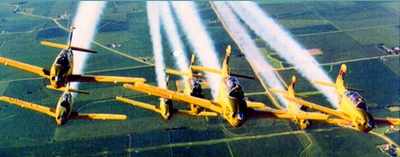Door Opens For T-34s to Resume Flight
 EAA Warbirds of America Executive
Director Bill Fischer represented members at a public meeting with
FAA and industry officials held February 15-16 in Kansas City
regarding the status of Beechcraft T-34 aircraft. The FAA proposed
short-, medium-, and long-term actions that could help return T-34s
to airworthy status. Over 70 industry representatives were in
attendance including the T-34 Association, the Commemorative Air
Force (CAF), and aircraft owners/operators.
EAA Warbirds of America Executive
Director Bill Fischer represented members at a public meeting with
FAA and industry officials held February 15-16 in Kansas City
regarding the status of Beechcraft T-34 aircraft. The FAA proposed
short-, medium-, and long-term actions that could help return T-34s
to airworthy status. Over 70 industry representatives were in
attendance including the T-34 Association, the Commemorative Air
Force (CAF), and aircraft owners/operators.
"On behalf of EAA Warbirds of America, we offer our support to
the T-34 Association and community, with whom we have many common
members," Fischer pledged. "We'll be following the situation very
closely with the FAA and report back to our members as soon as we
learn of new developments."
Discussion centered on technical issues and potential corrective
actions related to the type's continued operational safety in the
wake of several recent wing failure accidents. FAA-proposed actions
include:
-
 T-34 airframes with less than 3800
hours return to airworthy status with current required
inspections.
T-34 airframes with less than 3800
hours return to airworthy status with current required
inspections.
- T-34 airframes with less than 5700 hours return to airworthy
status with current required inspections, additional location
inspections and modifications, and proper documentation of
inspections and modification validity.
- The FAA issued Airworthiness Directive (AD) 2004-25-51 late
last year, essentially grounding the fleet because evidence from a
fatal accident of a Beech T-34A airplane on December 7 showed
fatigue in critical locations not evaluated from two previous
accidents.
"In all cases, the FAA expects proper documentation of
inspections and modifications," Fischer said. "They would like to
base their decisions on detailed information on aircraft usage and
maintenance history, using hard data, facts, and figures. With
proper data, higher time aircraft could return to airworthy
status."
T-34 Association representatives Dan Thomas and George Braly
reported that alternative means of compliance (AMOC) procedures had
been performed on 235 airframes at costs ranging from $15,000 to
$50,000 each. They pointed out the only fatigue problems found were
in the mock air combat/upset training aircraft.
The T-34 Association proposed to conduct an initial surface eddy
current test of 12 high-time air combat and commercial aerobatic
aircraft. Assuming no cracks are found in any aircraft other than
those operated in the air combat/upset training environment, the
association proposed that the fleet be immediately returned to
limited flight in Utility category.
After an initial surface eddy current inspection, each aircraft
would be returned to the original flight limits.
Additional surface eddy current inspection of the center section
on each T-34 will be followed by periodic inspections at intervals
to be determined. In addition, the T-34 Association proposes to
have all AMOC holders:
- Report any detectable cracks using a Malfunction Defect
Report
- Make any necessary repair of fatigue cracks with the approval
of a structural D.E.R.
- Placard to limit rolling Gs to 2.5
- Require a calibrated G meter in the front seat (if used for
instruction, also in the back seat)
- And require a thorough logbook review that will be submitted to
the AMOC holder.
Dave Saunders of Aviadesign, Inc. reported on the success of the
T-34 strap modification manufactured by his company. The FAA
commented that the strap modification reduces stress, which is a
positive result.

Marv Nuss, FAA Continued Operational Safety Program Manager at
the Small Airplane Directorate, said, "The door is open to get the
T-34s flying again."
The T-34 community will work closely with the FAA to continue
developing short-, medium-, and long-term solutions to this
issue.
 ANN's Daily Aero-Linx (04.16.24)
ANN's Daily Aero-Linx (04.16.24) Aero-News: Quote of the Day (04.16.24)
Aero-News: Quote of the Day (04.16.24) Airborne 04.10.24: SnF24!, A50 Heritage Reveal, HeliCycle!, Montaer MC-01
Airborne 04.10.24: SnF24!, A50 Heritage Reveal, HeliCycle!, Montaer MC-01 Airborne 04.12.24: SnF24!, G100UL Is Here, Holy Micro, Plane Tags
Airborne 04.12.24: SnF24!, G100UL Is Here, Holy Micro, Plane Tags Airborne-Flight Training 04.17.24: Feds Need Controllers, Spirit Delay, Redbird
Airborne-Flight Training 04.17.24: Feds Need Controllers, Spirit Delay, Redbird





